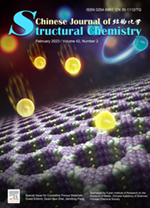Special Issue for Crystalline
Porous Materials
Quan-Guo Zhai*, Jiandong Pang*
February 15, 2023
ABSTRACT
The research of novel crystalline porous materials mainly focuses on the syntheses and applications of metal-organic frameworks (MOFs, also known as porous coordination polymers (PCPs)), covalent organic frameworks (COFs), and supramolecular organic frameworks (SOFs, including hydrogen-bonded organic frameworks (HOFs)). The novel crystalline porous materials are famous for their high surface areas, various structures, and adjustable functions, which show extensive application prospects in energy-, environment-, and catalysis-related fields. Therefore, novel crystalline porous materials have attracted great interests of scientists. In recent years, a series of fundamental and applied researches related to novel crystalline porous materials have been made. However, the rational design and synthesis of novel crystalline porous materials are still challenging, and further investigations are still highly required for the development of this field.
This special issue contains nine papers, which includes two short communications, six research articles, and one review. We thank a lot for the authors’ great contribution to this special issue. A brief summary of all nine accepted papers in this issue is provided as follows.
Firstly, in the short communication “Adenine-mediated amide-containing metal-organic framework toward one-step ethylene purification from a ternary mixture”, Dong-Xu Xue and co-authors report the construction of an amide-containing adenine-mediated rod MOF by means of mixed-linker approach. The 1D microporous channels replete with uncoordinated carboxylate oxygen atoms and amide groups enable the material one-step C2H4 separation ability from a ternary mixture of C2H2/C2H4/C2H6.
Another short communication “A 3D Ni8-cluster-based MOF as a molecular electrocatalyst for alcohol oxidation in alkaline media” reports a new MOF, CTGU-30, based on a novel Ni8(µ3-OH)4(COO)14 secondary building unit and a rare binodal (6,14)-connected network. Dong-Sheng Li, Xue-Qian Wu and co-authors found that CTGU-30 shows high electrocatalytic efficiency toward alcohol oxidation with the peak current densities ranging from 20.1 to 32.7 mA cm–2. This paper will promote the construction of MOF electrocatalysts based on highly-connected metal clusters for more energy conversion applications.
In the article “Smart crystalline frameworks constructed with bisquinoxaline-based component for multi-stimulus luminescent sensing materials”, Bao Li, Yuan Chen and co-authors report three crystalline porous frameworks (HOF and MOF) based on a bisquinoxaline-containing tetra-topic linker, which show excellent sensing properties. Fluorescence recognition of Fe3+, MnO4–, Cr2O72–, p-nitrotoluene, 2,4,6-trinitrotoluene, and metronidazole can be achieved by the reported materials. The optical responsive bisquinoxaline functional group introduced into the frameworks play a key role for the excellent sensing properties of the series of materials.
The article “Solid-state molecular dynamics of a torsion-variable ammonium embedded in a deformable supramolecular framework” reports the switchable molecular dynamics and order-disorder transformation of (i-PrNHMe2)+ cation embedded in a deformable {[Ni(NCS)6]4–} supramolecular framework accompanied by solid-state structural phase transitions. Ziyi Du and co-authors found that the confined swinging or flipping of the cation as a whole is assisted by a synergistic change of its torsion angle.
In the article titled “Robust microporous metal-organic framework with high moisture tolerance for efficient separation of propylene from propane”, Tong-Liang Hu and co-authors report a copper-based robust microporous MOF, Cu-Hmpba, constructed by the bifunctional pyridylcarboxylate ligand. Cu-Hmpba shows good water stability and C3H6/C3H8 selectivity according to the results of both experiments and simulations.
The paper “Polyoxometalate-encapsulated metal-organic frameworks with diverse cages for the C-H bond oxidation of alkylbenzenes” report three Fe-incorporated MOFs encapsulating polyoxometalates for catalytic C–H oxidation. Zhan-Gang Han, Jing Du, Yuan-Yuan Ma and co-authors found diverse cage-like building units in the three metal-organic host-guest frameworks. Thanks to the synergistic effect of the polynuclear Fe nodes and the polyoxoanions, all the three compounds show distinct catalytic activities toward diphenylmethane oxidation.
In the article “Control of pore environment in nickel-based metal-organic frameworks for SF6/N2 separation”, Qing-Yuan Yang and co-authors reported two Ni-based microporous MOFs constructed for SF6 capture form the SF6/N2 gas mixture. Due to their excellent structural stability and recyclability, the two Ni-MOFs both show remarkable SF6 separation performance and have the potential to be utilized in industrial applications, which has been confirmed by experimental and theoretical calculation results.
The research article “Water-soluble copper-based simulated enzyme: Biomimetic synthesis and activities in vitro” by Wenhuan Huang and co-authors describes the construction of two copper(II) complexes assembled using nitrogenous ligand. Due to the high similarity with the core structure of native Cu/Zn-SOD enzyme (SOD means superoxide dismutase), the two complexes become effective SOD mimics and catecholase mimics. It was confirmed that the SOD and catecholase activities of the two copper complexes are directly affected by the coordination mode of the central metal atom and the electrons acceptance ability of the compound.
The review “Advances in metal-organic frameworks for efficient separation and purification of natural gas” emphasizes on the recent advances for MOFs applied to natural gas separation and purification, mainly including the separation from C3H8/CH4, C2H6/CH4, H2S/CH4, CO2/CH4, and CH4/N2. Junkuo Gao, Xiaogang Yang and co-authors give an in-depth overview on the MOF structures related separation mechanism and future challenges faced by the field, and also discussed the possible research directions.






